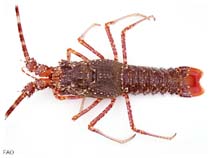Palinurus mauritanicus Gruvel, 1911
Pink spiny lobster| Native range | All suitable habitat | Point map | Year 2050 |

|
| This map was computer-generated and has not yet been reviewed. |
| Palinurus mauritanicus AquaMaps Data sources: GBIF OBIS |
Classification / Names Common names | Synonyms | CoL | ITIS | WoRMS
Malacostraca | Decapoda | Palinuridae
Environment: milieu / climate zone / depth range / distribution range Ecology
Benthic; depth range 180 - 600 m (Ref. 4), usually 200 - 400 m (Ref. 85373). Subtropical, preferred 18°C (Ref. 107945); 55°N - 14°N, 19°W - 17°E (Ref. 4)
Distribution Countries | FAO areas | Ecosystems | Occurrences | Introductions
Eastern Atlantic and the Mediterranean: from west Ireland to southern Senegal and western Mediterranean. Subtropical to temperate.
Length at first maturity / Size / Weight / Age
Maturity: Lm 9.0 range ? - ? cm Max length : 75.0 cm TL male/unsexed; (Ref. 441); common length : 45.0 cm BL male/unsexed; (Ref. 441); max. reported age: 21 years (Ref. 76525)
Life cycle and mating behavior Maturity | Reproduction | Spawning | Eggs | Fecundity | Larvae
Main reference
References | Coordinator | Collaborators
Goñi, R. and D. Latrouite 2005 Review of the biology, ecology and fisheries of Palinurus spp. species of European waters: Palinurus elephas (Fabricius, 1787) and Palinurus mauritanicus (Gruvel, 1911). Les Cahiers de Biologie Marine 46:127-142. (Ref. 85369)
IUCN Red List Status
(Ref. 130435: Version 2025-1)
CITES status (Ref. 108899)
CMS (Ref. 116361)
Threat to humans
Human uses
Fisheries: commercial
FAO - Fisheries: landings | FIRMS (Stock assessments) | FishSource | Sea Around Us
Tools
More information
Max. ages / sizes
Length-weight rel.
Length-length rel.
Length-frequencies
Mass conversion
Abundance
Internet sources
BHL | BOLD Systems | CISTI | DiscoverLife | FAO(Fisheries: ; publication : search) | Fishipedia | GenBank (genome, nucleotide) | GloBI | Gomexsi | Google Books | Google Scholar | Google | PubMed | Tree of Life | Wikipedia (Go, Search) | Zoological Record



